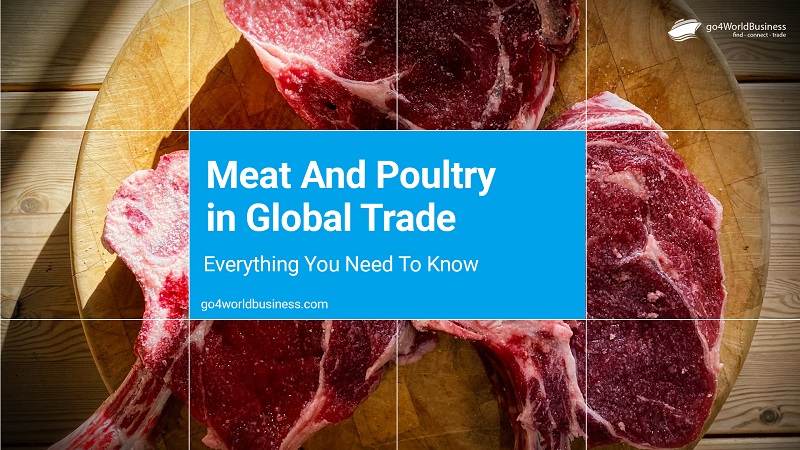

Do you know the key difference between meat and poultry? Well, meat comes from the muscle tissue of domestic mammals such as cattle, sheep, pigs, and goats, while poultry refers to meat from domesticated birds like chickens, turkeys, quails, and ducks. Both are good sources of protein and essential minerals, though they differ slightly in flavor, texture, and nutritional value. Humans have been eating meat and poultry since prehistoric times, when hunting was the main source of food. The Neolithic Revolution marked a turning point as people began to domesticate animals (specifically for meat). For centuries, meat has been seen as a symbol of prosperity and celebration, and this is what makes it a central part of human culture and trade.
As we all know, meat and poultry are one of the most traded food commodities in the world today, connecting millions of meat buyers, suppliers, and meat and poultry importers through a global supply chain. It is because of modern processing, refrigeration, and logistics that fresh and frozen meat now travel across borders safely and efficiently. Whether it’s for retail, restaurants, or industrial uses like sausage production and poultry feed, global demand continues to grow.
Having the knowledge of the most commonly traded types of meat and poultry can help you align your offerings with market demand and connect with the right buyers across borders. When we talk about meat, red meats such as beef, pork, lamb, mutton, goat, and veal are the most common. Moreover, game meats (like venison from deer or rabbit) are also traded. Other popular meat products include processed items like sausage, ham, and bacon, as well as meat from animals like carabeef, fish, and other seafood. Poultry mainly includes chicken, turkey, duck, and goose. Here we will take a look at each type and important export notes that you should keep in mind when trading these commodities.
From livestock, poultry, meat and animal products to seafood, exporters now deal in a range of items. This includes fresh meat, frozen meat, dried meat, and canned meat. Expanding your offerings to include poultry and poultry products, such as fresh chicken, frozen chicken, canned chicken, and chicken eggs, can help you attract more buyers. Your portfolio can also feature fresh mutton, frozen mutton, canned mutton, fresh beef, frozen beef, and canned beef. Offering this variety helps you meet different market demands and increase your profit potential.
It is very important to stay updated on key market insights to make smart, data-driven decisions for your export or import business. You can use this information to spot opportunities, connect with the right buyers, and grow your business faster.
Meat And Poultry Market Size:
Source: The Business Research Company
Top Meat And Poultry Importers Worldwide:
Sources: Volza (Meat); Volza (Poultry)
What Meat And Poultry Buyers Prefer:
Whether you are searching for broiler chicken buyers near you or poultry and meat importers around the world, the approach is generally the same.
1. Which countries are the top importers of meat and poultry?
The top importers of meat are the United States, Indonesia, and Vietnam. For poultry, the largest importers are the U.S., the Netherlands, and China.
2. What are the key market trends for meat and poultry?
The key market trends for meat and poultry includes growth in frozen and processed meat exports, rising poultry consumption, and increased demand for traceable and halal-certified products.
3. What types of meat and poultry products are in the highest demand internationally?
The most in-demand meat and poultry products are chicken breast, frozen beef, pork cuts, lamb meat, and processed products such as sausage and deli meats.
4. What certifications are required to export meat and poultry products?
HACCP, ISO, Halal, and health or veterinary certificates are commonly required (often based on the destination country).
5. Are there restrictions on exporting fresh meat versus frozen products?
Yes. Many countries impose tighter restrictions on fresh meat due to shorter shelf life and food safety risks. However, frozen and processed products often have fewer barriers.
6. How can exporters ensure product quality and freshness of meat during shipping?
As an exporter, you can ensure the quality and freshness of meat by using refrigerated containers, maintaining cold chain integrity, and including temperature monitoring systems during transport.
7. What are the current market prices for meat and poultry products?
Meat and poultry prices vary by product and region but usually range between USD 2.5 and 10 per kg depending on meat type and grade.
8. What is the meat & poultry HSN code?
The meat and poultry HSN codes fall under Chapter 02 of the Harmonized System. Some examples are:
9. How much is 1 kg of meat?
The average wholesale meat price for 1 kg ranges from USD 3 to 8, depending on the type, quality, and export destination.
The global poultry market stays strong in 2025 with a 2.5% growth forecast as balanced supply and lower feed costs keep prices steady. (Full Story: Rabobank)